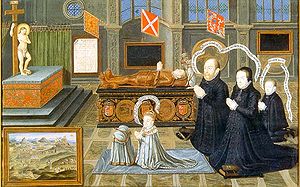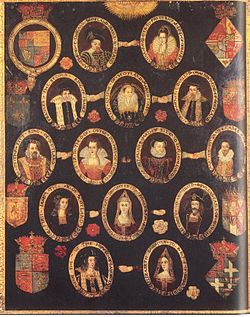- Matthew Stewart, 4th Earl of Lennox
-
 Matthew Stewart, Margaret Douglas, their son Charles Stewart, and grandson James VI of Scotland mourn Henry Stewart
Matthew Stewart, Margaret Douglas, their son Charles Stewart, and grandson James VI of Scotland mourn Henry Stewart
Matthew Stewart, 4th Earl of Lennox (21 September 1516 – 4 September 1571) was the 4th Earl of Lennox, and leader of the Catholic nobility in Scotland. He was the son of John Stewart, 3rd Earl of Lennox. His grandson was James VI of Scotland.
Elizabeth Hamilton. However, the Earl of Arran, James Hamilton, was descended from a son of Princess Mary, and thus held the stronger claim. As a result, Lennox was at best third in line of succession, and really behind Arran's sons. Arran was made Regent of Scotland In 1543, Lennox's supporters challenged Arran's claim and legitimacy by suggesting that his father's divorce and second marriage were invalid.[1]
Lennox arrived at Dumbarton Castle with two ships in March 1543. He came to Edinburgh but refused to ratify Arran's position as second person and Regent. Arran was pushing towards alliance with England and made the Treaty of Greenwich on 1 July 1543 agreeing to a marriage between Mary, Queen of Scots, and Henry VIII's son Edward, Prince of Wales. Arran began to fortify Linlithgow Palace where Queen Mary was held with her mother Mary of Guise. Cardinal Beaton's and Lennox's supporters camped outside the palace but lacked artillery for an assault. Their representatives parleyed with the Arran's men at Kirkliston, near Edinburgh, and a settlement was reached. Henceforth Arran would rule with the advice of a council and the infant queen would be moved to Stirling Castle. Lennox escorted Mary to Stirling on 26 July 1543.[2]
Although Lennox had come to Scotland lured by the prospect of marriage to Mary of Guise, by September Lennox had been offered the chance to marry Margaret Douglas, daughter of Margaret Tudor, and half-sister of the deceased James V. After Lennox seized French money and artillery sent to Mary of Guise she even offered the hand of her daughter in marriage.[3] When the Parliament of Scotland rejected the Greenwich treaty, Lennox then changed sides and supported Henry VIII of England's military efforts to secure a marriage between in the War of the Rough Wooing. After the defeat of his supporters at the Battle of Glasgow Muir he fled once more to England.
When the English army approached Edinburgh before the battle of Pinkie, far to the west a diversionary invasion of 5000 men was lead by Thomas Wharton and Lennox on 8 September 1547. They took Castlemilk and burnt Annan after a bitter struggle to capture its fortified church.[4]
Contents
Marriage and children
In 1544 he married Lady Margaret Douglas, which significantly improved the claim to the Scottish throne of any of his progeny, and also introduced a claim to the English throne. Their children were Henry Stewart, Lord Darnley, born 1545 at Temple Newsam, who married Mary, Queen of Scots, and Charles Stewart, future Earl of Lennox, was born in 1556 and died in 1576. Charles married Elizabeth Cavendish in 1574. Elizabeth was the daughter of William Cavendish and Elizabeth, Bess of Hardwick. Matthew's grandchildren were; by Henry, James VI of Scotland and I of England; and by Charles, Lady Arbella Stuart.
Father of the king and regency.
In August 1548 he made four promises to Mary of Guise in order for her assent to Queen Mary's French marriage. These were; that he and his friends and retainers would preserve the Catholic faith in Scotland; they would guard the Auld Alliance; Guise would remain guardian of Queen Mary; and he would punish all who supported the king of England.[5]
He returned to Scotland upon Elizabeth I of England's urging during the marriage negotiations of Mary, Queen of Scots, in 1564. He quickly took up his position as the most powerful lord in the Glasgow area and was instrumental in the marriage of his son, Lord Darnley, to Queen Mary. Whether Elizabeth had intended this (in order to eliminate the threat of a continental marriage), as is sometimes conjectured, remains doubtful. Elizabeth reacted with disapproval and had Lennox's wife confined in the Tower of London. By August 1565, William Cecil had heard that Darnley's insolence had driven Lennox from the Scottish court.[6]
After Darnley was murdered early in 1567, Lennox was the most ardent pursuant of justice against the lords who had conspired in the murder. He also became the main witness against Mary, though her involvement in the murder, thought to have been carried out by her later husband, Lord Bothwell, is controversial.
In 1570, Lennox became regent for his grandson, James VI, but the queen's party declared war against him. He was shot dead next year in a skirmish when the queen's party attacked Stirling. The raid on Stirling on 4 September 1571 was led by the Earl of Huntly, Claude Hamilton, and the lairds of Buccleuch and Ferniehurst. Early reports said he was killed by his own side. William Kirkcaldy of Grange said the shot was fired by the queen's party, and another account names David Bochinant as the assassin.[7]
Ancestors
Ancestors of Matthew Stewart, 4th Earl of Lennox Sir Alan Stewart, 2nd Seigneur d'Aubigny John Stewart, 1st Earl of Lennox Catherine Seton Matthew Stewart, 2nd Earl of Lennox Alexander, Master of Montgomerie Margaret Montgomerie Elizabeth Hepburn John Stewart, 3rd Earl of Lennox Sir James Hamilton, 5th Laird of Cadzow James Hamilton, 1st Lord Hamilton Janet Livingston Elizabeth Hamilton James II of Scotland Mary of Scotland Mary of Guelders Matthew Stewart, 4th Earl of Lennox Sir John Stewart, Lord of Lorn Sir James Stewart, the Black Knight of Lorn Isabel de Ergadia John Stewart, 1st Earl of Atholl John Beaufort, 1st Earl of Somerset Joan Beaufort Margaret Holland Elizabeth Stewart Henry II Sinclair, Earl of Orkney William Sinclair, 1st Earl of Caithness Egidia Douglas Eleanor Sinclair Alexander Sutherland Marjory Sutherland Mariotta Macdonald References
- ^ Dickinson, Gladys, ed., Two Missions of de la Brosse, Scottish History Society (1942), 7-8, 19: Calendar State Papers Scotland, vol, 1 (1898), 691-694.
- ^ Marshall, R. K., Mary of Guise, Collins (1977), 126-130: Merriman, Marcus, The Rough Wooing, Tuckwell (2000), 124-126: Furgol, Edward M., The Scottish Itinerary of Mary Queen of Scots, PSAS, vol. 107, (1989), 119-231.
- ^ Marshall, R. K., Mary of Guise, Collins (1977), 139-140.
- ^ Tytler, Patrick Fraser, History of Scotland, vol. 3,(1879), 63: Calendar State Papers Scotland, vol. 1, (1898), p.19 no.42, Lennox & Wharton to Somerset, 16 September 1547.
- ^ HMC, 9th report part 2, Alfred Morrison, (1884), 414-5.
- ^ Ellis, Henry, Original Letters, second series, vol. 2, (1827), 303, Cecil to Thomas Smith, 1 September 1565.
- ^ Calendar State Papers Scotland, vol. 3 (1903), 679-687.
Alan Stewart Cradle King
Government offices Preceded by
The Earl of MorayRegent of Scotland
1570–1571Succeeded by
The Earl of MarRegnal titles Preceded by
John StewartEarl of Lennox Succeeded by
Lapsed into Crown[Known] Mormaers/Earls from Lennox line (to 1458)
David of Huntingdon ¶ · Ailín I · Ailín II · Maol Domhnaich · Maol Choluim I · Maol Choluim II · Domhnall · Margaret with Baltar mac Amlaimh · Donnchadh · Isabella with Murdoch Stewart, Duke of AlbanyStewart Earls (1488–1581)
John Stewart · Matthew Stewart · John Stewart · Matthew Stewart · Charles Stewart · Robert Stewart · Esmé StewartStewart Dukes (1581–1672)
Esmé Stewart · Ludovic Stewart · Esmé Stewart · James Stewart · Esmé Stewart · Charles Stewart
¶ - Not from Lennox lineCategories:- Earls in the Peerage of Scotland
- 1516 births
- 1571 deaths
- Earls or mormaers of Lennox
- Regents of Scotland
- Scottish pre-union military personnel killed in action
- House of Stewart of Darnley
- The Rough Wooing
Wikimedia Foundation. 2010.

